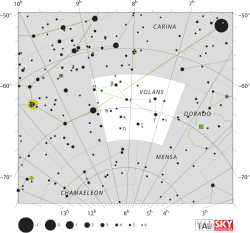Beta Volantis
Beta Volantis, Latinized from β Volantis, is the brightest star of the southern constellation of Volans. It has an apparent visual magnitude of 3.75,[2] which is sufficiently bright to allow it to be viewed with the naked eye. Based upon an annual parallax shift of 30.33 mas as seen from Earth, its distance can be estimated as 107.5 light years from the Sun. The star is moving away from the Sun with a radial velocity of +27 km/s.[4]
 | |
| Observation data Epoch J2000 Equinox J2000 | |
|---|---|
| Constellation | Volans |
| Right ascension | 08h 25m 44.19472s[1] |
| Declination | −66° 08′ 12.8050″[1] |
| Apparent magnitude (V) | 3.75[2] |
| Characteristics | |
| Spectral type | K2 III[3] |
| B−V color index | +1.13[2] |
| Astrometry | |
| Radial velocity (Rv) | +27.4±0.7[4] km/s |
| Proper motion (μ) | RA: −35.74±0.10[1] mas/yr Dec.: −152.22±0.10[1] mas/yr |
| Parallax (π) | 30.33 ± 0.10[1] mas |
| Distance | 107.5 ± 0.4 ly (33.0 ± 0.1 pc) |
| Absolute magnitude (MV) | +1.18[5] |
| Details | |
| Mass | 1.62±0.20[6] M☉ |
| Luminosity | 41±3[6] L☉ |
| Temperature | 4,546[6] K |
| Metallicity [Fe/H] | −0.01[7] dex |
| Other designations | |
| Database references | |
| SIMBAD | data |
This is a single,[9] orange-hued star with a stellar classification of K2 III,[3] indicating it is an evolved K-type giant star. It is a red clump star,[10] which means it is on the horizontal branch and is generating energy through helium fusion at its core. The stellar mass has been estimated via astroseismology, giving a value of 1.6 times the mass of the Sun.[6] It is radiating about 41 times the Sun's luminosity from its enlarged photosphere at an effective temperature of 4,546 K.[6]
References
- van Leeuwen, F. (November 2007), "Validation of the new Hipparcos reduction", Astronomy and Astrophysics, 474 (2): 653–664, arXiv:0708.1752, Bibcode:2007A&A...474..653V, doi:10.1051/0004-6361:20078357.
- Cousins, A. W. J. (1977), "Cape UBV magnitudes and colours of South circumpolar stars", South African Astronomical Observatory Circulars, 1: 51, Bibcode:1977SAAOC...1...51C.
- Gray, R. O.; et al. (2003), "Contributions to the Nearby Stars (NStars) Project: Spectroscopy of Stars Earlier than M0 within 40 Parsecs: The Northern Sample. I", The Astronomical Journal, 126 (4): 2048, arXiv:astro-ph/0308182, Bibcode:2003AJ....126.2048G, doi:10.1086/378365.
- Gontcharov, G. A. (November 2006), "Pulkovo Compilation of Radial Velocities for 35495 Hipparcos stars in a common system", Astronomy Letters, 32 (11): 759–771, arXiv:1606.08053, Bibcode:2006AstL...32..759G, doi:10.1134/S1063773706110065.
- Anderson, E.; Francis, Ch. (2012), "XHIP: An extended hipparcos compilation", Astronomy Letters, 38 (5): 331, arXiv:1108.4971, Bibcode:2012AstL...38..331A, doi:10.1134/S1063773712050015.
- Stello, D.; et al. (2008), "Oscillating K Giants with the WIRE Satellite: Determination of Their Asteroseismic Masses", The Astrophysical Journal Letters, 674 (1): L53–L56, arXiv:0801.2155, Bibcode:2008ApJ...674L..53S, doi:10.1086/528936.
- Heiter, U.; Jofré, P.; Gustafsson, B.; Korn, A. J.; Soubiran, C.; Thévenin, F. (2015), "Gaia FGK benchmark stars: Effective temperatures and surface gravities", Astronomy & Astrophysics, 582: A49, arXiv:1506.06095, Bibcode:2015A&A...582A..49H, doi:10.1051/0004-6361/201526319.
- "bet Vol". SIMBAD. Centre de données astronomiques de Strasbourg. Retrieved 2017-09-09.
- Eggleton, P. P.; Tokovinin, A. A. (September 2008), "A catalogue of multiplicity among bright stellar systems", Monthly Notices of the Royal Astronomical Society, 389 (2): 869–879, arXiv:0806.2878, Bibcode:2008MNRAS.389..869E, doi:10.1111/j.1365-2966.2008.13596.x.
- Paczynski, B.; et al. (September 1999), "The Optical Gravitational Lensing Experiment. UBVI Photometry of Stars in Baade's Window", Acta Astronomica, 49: 319–339, arXiv:astro-ph/9908043, Bibcode:1999AcA....49..319P.